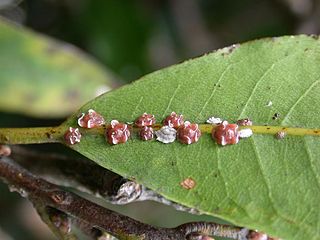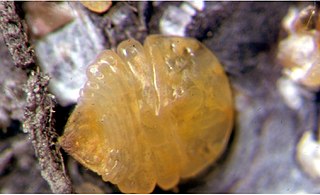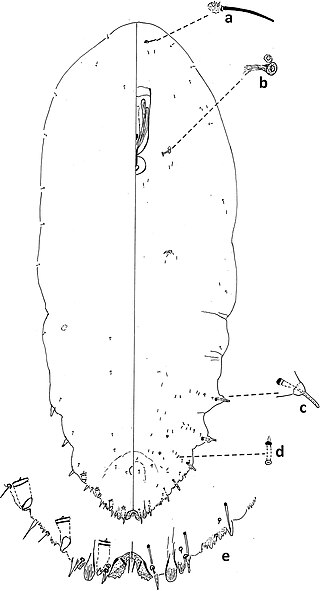
Whiteflies are Hemipterans that typically feed on the undersides of plant leaves. They comprise the family Aleyrodidae, the only family in the superfamily Aleyrodoidea. More than 1550 species have been described.

Scale insects are small insects of the order Hemiptera, suborder Sternorrhyncha. Of dramatically variable appearance and extreme sexual dimorphism, they comprise the infraorder Coccomorpha which is considered a more convenient grouping than the superfamily Coccoidea due to taxonomic uncertainties. Adult females typically have soft bodies and no limbs, and are concealed underneath domed scales, extruding quantities of wax for protection. Some species are hermaphroditic, with a combined ovotestis instead of separate ovaries and testes. Males, in the species where they occur, have legs and sometimes wings, and resemble small flies. Scale insects are herbivores, piercing plant tissues with their mouthparts and remaining in one place, feeding on sap. The excess fluid they imbibe is secreted as honeydew on which sooty mold tends to grow. The insects often have a mutualistic relationship with ants, which feed on the honeydew and protect them from predators. There are about 8,000 described species.

Diaspididae is the largest family of scale insects with over 2650 described species in around 400 genera. As with all scale insects, the female produces a waxy protective scale beneath which it feeds on its host plant. Diaspidid scales are far more substantial than those of most other families, incorporating the exuviae from the first two nymphal instars and sometimes faecal matter and fragments of the host plant. These can be complex and extremely waterproof structures rather resembling a suit of armor. For this reason these insects are commonly referred to as armored scale insects. As it is so robust and firmly attached to the host plant, the scale often persists long after the insect has died.
Conchaspididae is a small family of scale insects known as false armoured scales because of their resemblance to Diaspididae.

Aleurocanthus woglumi is a species of whitefly in the family Aleyrodidae. It is a pest of citrus crops, and is commonly known as the citrus blackfly because of its slate-blue colour. It originated in Asia, but has spread to other parts of the world. The parasitic wasps, Encarsia perplexa and Amitus hesperidum can help control the pest.

Halimococcidae is a family of scale insects in the order Hemiptera. Members of the family are commonly known as pupillarial palm scales or halimococcids. Most species are found on the leaves of palm trees where they suck sap, but some species occur on Pandanus. The family was named by Brown and McKenzie in 1962 and includes five known genera and twenty one species.

Aulacaspis yasumatsui, or cycad aulacaspis scale (CAS), is a scale insect species in the genus Aulacaspis that feeds on cycad species such as Cycas revoluta or Dioon purpusii. Other common names include the cycad scale, the sago palm scale, and the Asian cycad scale. This is a serious pest of cycads which can kill its host plant.

Fiorinia is a genus of armored scale insects with around 70 species. The species are widely distributed around the world. However, the large majority of them are found in southern Asia. They infest woody plants like forest or crop trees, palm trees and shrubs. Several species are invasive and these are mainly polyphagous species which have spread with the trade of ornamentals. For example, 7 species have been introduced into North America.

Aonidiella orientalis is a species of insect in the family Diaspididae, the armored scale insects. It is known commonly as the Oriental yellow scale. It is an agricultural pest on a wide variety of crop plants.

Pseudaulacaspis pentagona, the white peach scale or mulberry scale, is a species of armoured scale insect in the family Diaspididae. This scale infests over 100 different genera of plants including many fruit trees and ornamentals.

Hemiberlesia lataniae, the latania or palm scale, is a species of armored scale insect in the family Diaspididae. It was first described by the French entomologist Victor Antoine Signoret in 1869 using Latania lontaroides, a species of palm tree endemic to Réunion as its host; since then, it has been found on avocado trees growing in South Africa, Australia, Israel, the United States, and on a range of other plants in many parts of the world.

Aspidiotus destructor, the coconut scale, is a species of armoured scale insect in the family Diaspididae, found in many tropical and subtropical parts of the world. It is a serious pest of coconut and banana, and attacks a range of other fruiting trees and ornamental plants.

Ceroplastes rubens, known generally as the red wax scale or pink wax scale, is a species of soft scale insect in the family Coccidae. It is native to Australia but has been introduced to other countries, including New Caledonia, Japan, China, Poland and the United States.

Aleurocanthus spiniferus, the citrus spiny whitefly, is an insect native to Asia. It is considered an invasive pest, notably affecting citrus and tea plants. They are part of the whitefly family.

Diaspidiotus juglansregiae, commonly known as the walnut scale, is a species of armoured scale insect in the family Diaspididae. It is native to North America where it feeds on a wide range of ornamental and forest trees and bushes.
Selenaspidus articulatus is an armoured scale insect in the family Diaspididae, commonly known as the West Indian red scale. It is a polyphagous species found in tropical and subtropical regions around the world as a pest species of Citrus and other fruit and ornamental trees.
Aleurodicus cocois, commonly known as the coconut whitefly, is a species of whitefly in the family Aleyrodidae; it feeds on coconut and other palm trees in South America and the Caribbean region.

Fiorinia externa, the elongate hemlock scale was accidentally introduced into North America from Japan and is now established in most parts of the north-eastern U.S. It has become a serious pest of hemlock (Tsuga) and some related conifers from the family Pinaceae. Dense colonies of the scale insect result in yellowing, shedding of leaves, dieback and occasional tree death.

Fiorinia theae, the tea scale, is a polyphagous scale insect which is native to Asia and has been introduced into the Americas. It is widely distributed on both continents, especially in warmer regions. Apart from tea, the host plants include a range of trees and shrubs, both ornamentals and crops. For example, other Camellia species, Citrus or Ilex (holly) species are part of the host range. Infested plants turn yellow and might die after heavy infestation.

Fiorinia fioriniae is a highly polyphagous scale insect and widely distributed around the world, being found in Asia, Australia/Pacific, Africa, Europe and the Americas. Its vernacular names include fiorinia scale, palm fiorinia scale, and avocado scale. It can cause significant damage to palms, avocado as well as other fruit and ornamental trees. It has been cited as one of two species of Fiorinia in a list of 43 "principle armoured scale pests of the world".

















